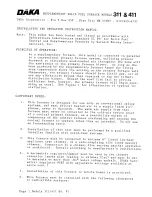
4. Deburr inside and outside of pipe.
5. Chamfer outside edge of pipe for better distribution of
primer and cement.
6. Clean and dry all surfaces to be joined.
7. Check dry fit of pipe and mark insertion depth on pipe.
NOTE:
It is recommended that all pipes be cut, prepared, and
preassembled before permanently cementing any joint.
8. After pipes have been cut and preassembled, apply gener-
ous layer of cement primer to pipe fitting socket and end of
pipe to insertion mark. Quickly apply approved cement to
end of pipe and fitting socket (over primer). Apply cement
in a light, uniform coat on inside of socket to prevent
buildup of excess cement. Apply second coat.
9. While cement is still wet, twist pipe into socket with 1/4
turn. Be sure pipe is fully inserted into fitting socket.
10. Wipe excess cement from joint. A continuous bead of
cement will be visible around perimeter of a properly made
joint.
11. Handle pipe joints carefully until cement sets.
12. Support combustion-air and vent piping a minimum of
every 5 ft (3 ft for SDR-21 or -26 PVC) using perforated
metal hanging strap.
13. Slope combustion-air and vent pipes toward furnace a
minimum of 1/4 in. per linear ft with no sags between
hangers.
14. Use appropriate methods to seal openings where vent and
combustion-air pipes pass through roof or side wall.
III.
CONCENTRIC VENT AND COMBUSTION-AIR
TERMINATION KIT INSTALLATION
NOTE:
If these instructions differ from those packaged with
termination kit, follow kit instructions.
Combustion-air and vent pipes must terminate outside structure. A
factory accessory termination kit must be installed in 1 of the
installations shown in Fig. 22, 23, 24, 25, or 26. Four termination
kits are available.
1. The 2-in. termination bracket kit is for 1-1/2 in., and 2-in.
diameter 2-pipe termination systems.
2. The 3-in. termination bracket kit is for 2-1/2 in. diameter
2-pipe termination systems.
3. The 2-in. concentric vent/air termination kit is for 1-1/2 in.,
2-in., and 2-1/2 in. diameter pipe systems when single
penetration of wall or roof is desired.
4. The 3-in. concentric vent/air termination kit is for 2-1/2 in.,
diameter pipe systems when single penetration of wall or
roof is desired.
NOTE:
Shaded parts in Fig. 22, 23, 24, 25, and 26 are considered
to be termination. These components should NOT be counted
when determining pipe diameter. Roof termination is preferred
since it is less susceptible to damage, has reduced chances to take
in contaminants, and has less visible vent vapors. (See Fig. 22 or
23.) Sidewall termination may require sealing or shielding of
building surfaces with a corrosive resistance material due to
corrosive combustion products of vent system.
A.
Extended Exposed Sidewall Pipes
Sidewall combustion-air and vent pipe terminations may be
extended beyond area shown in Fig. 25 or 26 in outside ambient by
insulating pipes as indicated in Table 8.
1. Determine combustion-air and vent pipe diameters, as
stated above, using total pipe length and number of elbows.
2. Using winter design temperature (used in load calculations),
find appropriate temperature for your application and fur-
nace model.
3. Determine required insulation thickness for exposed pipe
lengths.
NOTE:
Pipe length (ft) specified for maximum pipe lengths
located in unconditioned spaces cannot exceed total allowable pipe
length as specified in Table 7.
B.
Two-Pipe Termination Kit
1. Determine location for termination.
Consideration of the following should be made when
determining an appropriate location for termination kit.
a. Comply with all clearance requirements as stated in
Table 6.
b. Termination kit should be positioned where vent vapors
will not damage plants/shrubs or air conditioning equip-
ment.
c. Termination kit should be positioned so that it will not be
affected by wind eddy (such as inside building corners)
or allow recirculation of flue gases, airborne leaves, or
light snow.
d. Termination kit should be positioned where it will not be
damaged by or subjected to foreign objects, such as
stones, balls, etc.
e. Termination kit should be positioned where vent vapors
are not objectionable.
2. Cut 2 holes, 1 for each pipe, of appropriate size for pipe size
being used.
3. Loosely install elbow in bracket and place assembly on
combustion-air pipe.
Roof terminations—Loosely install pipe coupling on prop-
erly cut vent pipe. Coupling must be positioned so bracket
will mount as shown in Fig. 22.
For applications using combustion-air pipe option, indi-
cated by dashed lines in Fig. 22, install 90° street elbow into
90° elbow, making U-fitting. A 180° U-fitting may be used.
Sidewall terminations—Install bracket as shown in Fig. 25
or 26.
For applications using vent pipe option indicated by dashed
lines in Fig. 25, rotate vent elbow 90° from position shown
in Fig. 25.
4. Disassemble loose pipe fittings. Clean and cement using
same procedures as used for system piping.
5. Check required dimensions as shown in Fig. 22, 25, or 26.
C.
Concentric Vent/Air Termination Kit
1. Determine location for termination.
Consideration of the following should be made when
determining an appropriate location for termination kit.
a. Comply with all clearance requirements as stated in
Table 6.
b. Termination kit should be positioned where vent vapors
will not damage plants/shrubs or air conditioning equip-
ment.
c. Termination kit should be positioned so it will not be
affected by wind eddy (such as inside building corners)
or that may allow recirculation of flue gases, airborne
leaves, or light snow.
d. Termination kit should be positioned where it will not be
damaged by or subjected to foreign objects, such as
stones, balls, etc.
e. Termination kit should be positioned where vent vapors
are not objectionable.
—19—
Содержание 351DAS
Страница 35: ...35...








































